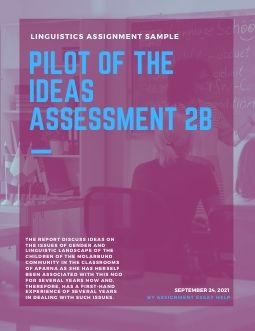
You can download the sample Linguistics case study on Cognitive Approaches to Discourse Analysis with the following question for free at the end of this page. For further assistance with Linguistics Assignment help, please check our offerings in Linguistics assignment solutions. Our subject-matter experts provide online assignment help to Linguistics students from across the world and deliver plagiarism free solution with a free Turnitin report with every solution.
(AssignmentEssayHelp does not recommend anyone to use this sample as their own work.)
Linguistics Assignment Question
Arpana, a non – profit organization based in India, improves health, provides education and enhances livelihood for over 330,000people in rural Haryana, Himachal Pradesh and in Delhi slums (Arpana Services, 2012).
I was fortunate to be born in such an atmosphere. From the age of 18, when I finished school, I developed an interest in the services of this NGO. Often when I had time off from my university, I would accompany my mother to the villages she so passionately worked in. After I finished my bachelor’s degree, I decided to work for the organization hands on. I also got a chance to work in the Delhi slums and attend seminars organized for the teachers and rural community workers. Before I reflect more upon my experience with Arpana, I would like to throw some light on its spheres of operation.
Arpana began in 1962, through Param Pujya Ma, its founder and inspiration. I would like to focus more on Arpana’s Educational activities in the slum resettlement colonies of Molarbund, New Delhi. At Molarbund, New Delhi, illiterate families struggling to survive in urban poverty know that their children face a bleak future. Even when admitted to school, crowded classrooms, teacher absenteeism, lack of proper instructional methods leave these first generation learners bewildered and unable to keep up with the lessons. Moreover, there is a mixture of languages spoken by the population there and that made it more difficult for the children to understand anything going on in the class. The Slum children often dropped out and took to the streets.
The Educational program started in the year 2002. A good population of this community is migratory and it is always a challenge to provide an even ground for all of them. But with the constant perseverance and motivation of the community mobilizers, teachers and other stakeholders, children are getting quality education and scoring well in the Standardised Exams held for year 10 and year 12 in India.
RECOMMENDATIONS
In order to create a more multilingual environment in Molarbund, the following recommendations could be incorporated:
- PARTICIPATION IN LITERARY FAIRS
Delhi is one of the metropolitan states of India. There are events being organized at a regular basis by the state government. A competition could be organized which could provide students with the opportunity to present their favourite fiction / non – fiction novel in a “fair” atmosphere.
This would develop the reading habit in the students. It would also lead to good comprehension skills. The students would be able to read complex texts and also understand the information. It would be an exciting opportunity to develop their love of reading and also promote linguistic competence.
- SPOKEN ENGLISH CLASSES
The population in the slum resettlement colony is of migrants; therefore, students come from various parts of India. They have different dialects and sometimes speak a different language all together. It is very essential to bring them to a common platform. Arranging for English speaking classes could be a step towards making Molarbund a more multilingual place.
- LIBRARY
Molarbund has a well catalogued library with more than 8000 books in Hindi and English. Adding books to the library would be a useful step towards promoting multilingualism. Goethe- institut (2017) noted that “Everyone should have an opportunity to hold and look at a book in Arabic, for example, you have to open it ‘from the back’, you read it the other way around!”
- EXPOSURE TRIPS
India has a rich cultural and historical heritage. Delhi is situated in the north of the country and has had a vibrant past. The students could be taken to the nearby monuments and historical locations. The children will get a chance to interact with other students from different backgrounds. In this way, even the minority language could also be encouraged. This would lead to a multilingual atmosphere.
CONCLUSION
The community of Molarbund has experienced the unfolding of their child’s full potential. Every year the queue of the admissions increases. The patriarchal mind set of the people is changing gradually. They are realizing the importance of education in their lives.
There are also some minority migrant groups whose language might just disappear after this generation as it is not frequently spoken. To avoid such a situation, the above mentioned recommendations can be incorporated.
Linguistics Assignment Solution
Interview Information: Telephonic. 15 mins long. Audio recording and transcript attached.
Interviewee: My mother, Mrs. Name.
I chose my mother to discuss my ideas on the issues of gender and linguistic landscape of the children of the Molarbund community in the classrooms of Aparna as she has herself been associated with this NGO for several years now and, therefore, has a first-hand experience of several years in dealing with such issues. I presented my ideas one by one to her, on which she gave her valuable feedback, which I have collated in this report as follows:
Creating and Managing a Multilingual and Multicultural Space
From what I have read and seen, Aparna classrooms can be called a multilingual and multicultural space. I began my interview by asking my mother what practices are followed to maintain and manage such a good balance of students from across different linguistic and cultural identities in the classrooms. My mother said, to begin with, Aparna has its doors open for children from all linguistic, cultural or ethnic backgrounds. Neither the admissions, the administration, the teachers, nor the classrooms are run with the hegemony of any particular language or ideology. Aparna is open for every child who wants to come in. Next, moving on to the issue of management of a class with such a diverse populace, she added, we make sure that we train our teachers enough with the right pedagogical methods and provide them with adequate teaching aids and resources that are well researched to enable them to handle such a challenging class. This means, instead of forcing students to learn a common, standard variety of a dominant Indian language, we ask our teachers to mould as per the requirements of the students. This definitely sounds challenging, but in practice, it is totally possible (Lauridsen & Lillemose, 2015).


 WhatsApp Us
WhatsApp Us